
Munitions Traders in Game Update 5 have a new system for crafting weapons in Game Update 5! Weapon cores allow the weaponsmith to choose the look of the weapon, the elemental type, and more.
Choose Your Level
Cores, similar to cores used when armorsmithing, are crafted subcomponents used to select the level of the weapon the trader is crafting. Cores also derive most of the damage caused by the crafted weapon.
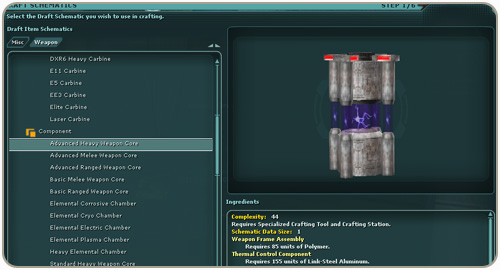
Core levels range from level 18-90, depending on the core type, and the level determines the weapon stats. Types of weapon cores include:
- Basic Ranged Weapon Core
- Standard Ranged Weapon Core
- Advanced Ranged Weapon Core
- Standard Heavy Weapon Core
- Advanced Heavy Weapon Core
- Basic Melee Weapon Core
- Standard Melee Weapon Core
- Advanced Melee Weapon Core
Each core has a level range of even levels (18, 20, 22, and so on). Basic cores create weapons level 18-40, standard cores are level 42-72, and advanced cores are 74-90.
Choosing the level of the weapon also gives the Munitions Trader the opportunity to select the weapon appearance. Since weapon appearances have no intrinsic levels in them, Munitions Traders could place a level 90 ranged weapon core into a CDEF Pistol, create a level 12 Intimidator pistol, and more.
When crafting the weapon, place the core into any weapon appearance you have the schematic for. The Core Level slider in the Experimentation window must be used before spending the first experimentation point. Each increment of the Core Level slider increases the level by two. Selecting the level cannot be undone, so choose carefully!
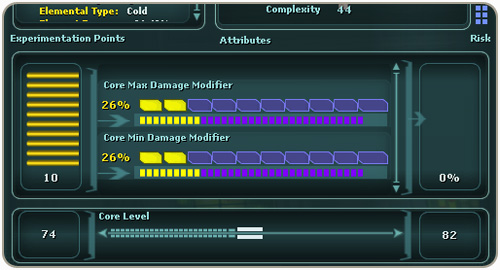
Class restrictions on certain weapons will remain, so in the Intimidator example above, the weapon will still be limited to officers.
All weapons created by the Munitions Trader must be bio-linked before use.
Sub-Components
Several new sub-components have also been added in Game Update 5, and existing sub-components can be used in crafting the cores and weapons.
Elemental damage type is determined at the core level. Munitions Traders can craft the elemental type into the core to place it into weapons that don't have an element type defined. Core components with elemental types include the Elemental Corrosive Chamber (Acid), Elemental Cryo Chamber (Cold), Elemental Electric Chamber (Electric), and Elemental Plasma Chamber (Heat).
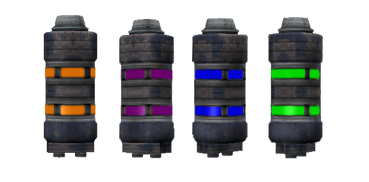
Munitions Traders use the Heavy Elemental Chamber, a required component of heavy weapon cores, to increase the elemental damage of crafted heavy weapons. Gas Cartridges are required sub-components for ranged weapon cores, and Reinforcement Cores are required to create melee weapon cores.
Blaster and Projectile Barrels can increase the damage of ranged weapons, and Vibro Units can increase the damage of melee weapons. Stocks and scopes also increase the damage of ranged weapons.
Weapon Power Bits are sub-components that allow the Munitions Trader to add skill mods to the weapon during crafting. Combine one modifier bit and one reverse-engineered power bit to create this subcomponent.
Weapon Power Bits add one stat, which can be a standalone stat or one that is already granted by a socket. The stats a Weapon Power Bit can add are the same ones that can be put into a powerup, and the stat's power is diffused by 60%.
Weapon enhancements and augments, which affect stat modifiers such as critical hit chance and health/action respectively, are looted sub-components new in Game Update 5.
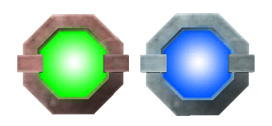
Existing Weapons
Weapons that existed prior to Game Update 5 have not been changed or converted, but can be dismantled into tradable draft schematics that can be used in the new crafting system.
Use the radial menu on the weapon in the inventory and select Deconstruct. You must confirm your decision to dismantle your weapon.
If you choose to deconstruct, the weapon is destroyed and permanently turned into a schematic for the Munitions Trader. Once learned, the limited use schematic is displayed in the crafting list.
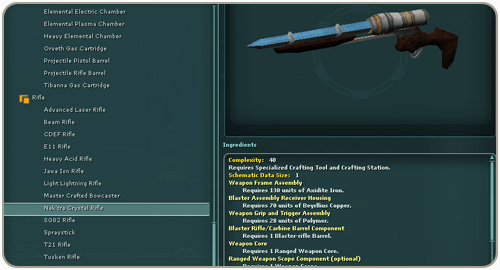
The Munitions Trader can craft the weapon to any level (depending on the core used) and with any of the sub-components listed above. The weaponsmith can also choose a custom name for the new weapon at the end of the crafting process.
Not every weapon can be dismantled. When looking to deconstruct a weapon, it can't be equipped and must be in your inventory. Lightsabers, weapons that can already be crafted by Munitions Traders, and some looted weapons cannot be deconstructed.
The newly crafted weapon is tradable but must be bio-linked before equipping it.
With new level, elemental, and sub-component options at their disposal, Munitions Traders can truly create their weapon of choice in Game Update 5!
The following is a list of usefull gear/items:
- Weapon, Droid, and Generic Item Crafting Tool - The closer to 15.00 effectiveness the better. I recommend getting a couple of them so you're not waiting for items to finish being made.
- Weapon, Droid and Generic Item Crafting Station - The closer to 45.00 functionality the better. This is required to craft high complexity items.
- Weaponsmith Suit* - You should be able to get this suit made for fairly cheap nowadays. A suit made with the current RE system will consist of a weapon, shirt and chestplate with weapon experimentation and assembly modifiers built into. A SEA can have up to +8 weapon experimentation and +11 weapon assembly added to it. Furthermore a +4 weapon assembly bonus can be built into the weapon and chestplate.
- Relic Weaponsmith Ring - This grants a +10 bonus to weapon assembly. It's not required, but certainly nice to have.
- Equipment Factories - Definitely a must for weaponsmith, you'll be making a lot of factory crates of subcomponents and weapons (if you choose to produce a lot of weapons to sell)
- Additionally you can add +35 luck modifiers to your luck suit
A few words about your expertise setup
If you plan on being a competitive weaponsmith, the resource processing and advanced resource refinement boxes are a must for the resource quality bonus. Furthermore, the weaponsmith advanced theory box is also essential for the extra experimentation point. In order to get the weaponsmith advanced theory box, you'll need to put 4 points into weaponsmith hypothesis and weaponsmith dexterity. Weaponsmith insight and weaponsmith keen understanding aren't essential boxes, so if you don't have the points to spend, don't worry about getting those boxes.
Resource Shopping List
Below is a list of all resources (and their experimental percentages) that you will encounter as a weaponsmith:
Generic Resources
- Aluminum (66% OQ / 33% SR)
- Carbonate Ore (66% CD / 33% OQ)
- Carbonate Ore (66% OQ / 33% SR)
- Copper (33% OQ / 66% SR)
- Copper (66% OQ / 33% SR)
- Chemical (33% OQ / 66% SR)
- Chemical (50% CD / 50% OQ)
- Chemical (66% OQ / 33% SR)
- Crystalline Gemstone (66% OQ / 33% SR)
- Crystalline Gemstone (50% CD / 50% OQ)
- Crystalline Gemstone (33% OQ / 66% SR)
- Gemstone (33% OQ / 66% SR)
- Inert Petrochemical (50% CD / 50% OQ)
- Inert Petrochemical (33% OQ / 66% SR)
- Inert Petrochemical (66% OQ / 33% SR)
- Iron (66% OQ / 33% SR)
- Iron (50% CD / 50% OQ)
- Ferrous Metal (50% CD / 50% OQ)
- Ferrous Metal (66% OQ / 33% SR)
- Ferrous Metal (33% OQ / 66% SR)
- Liquid Petrochem Fuel (66% OQ / 33% SR)
- Metal (66% OQ / 33% SR)
- Metal (50% CD / 50% OQ)
- Metal (33% OQ / 66% SR)
- Mineral (66% OQ / 33% SR)
- Non-Ferrous Metal (66% OQ / 33% SR)
- Non-Ferrous Metal (50% CD / 50% OQ)
- Non-Ferrous Metal (33% OQ / 66% SR)
- Polymer (66% OQ / 33% SR)
- Polymer (50% CD / 50% OQ)
- Polymer (33% OQ / 66% SR)
- Polymer (66% CD / 33% OQ)
- Reactive Gas (66% CD / 33% OQ)
- Reactive Gas (66% OQ / 33% SR)
- Reactive Gas (50% CD / 50% OQ)
- Siliclastic Ore (66% OQ / 33% SR)
- Solid Petrochem Fuel (33% OQ / 66% SR)
- Steel (66% OQ / 33% SR)
- Steel (33% OQ / 66% SR)
- Wood (66% OQ / 33% SR)
Steel
- Carbonite Steel (66% OQ / 33% SR)
- Carbonite Steel (50% CD / 50% OQ)
- Ditanium Steel (66% OQ / 33% SR)
- Duralloy Steel (33% OQ / 66% SR)
- Duralloy Steel (66% OQ / 33% SR)
- Duranium Steel (33% OQ / 66% SR)
- Neutronium Steel (66% OQ / 33% SR)
- Quadranium Steel (33% OQ / 66% SR)
- Rhodium Steel (33% OQ / 66% SR)
Iron
- Axidite Iron (33% OQ / 66% SR)
- Bronzium Iron (33% OQ / 66% SR)
- Colat Iron (66% OQ / 33% SR)
- Doonium Iron (66% OQ / 33% SR)
- Kammris Iron (66% OQ / 33% SR)
- Plumbum Iron (66% OQ / 33% SR)
- Plumbum Iron (33% OQ / 66% SR)
- Polonium Iron (66% OQ / 33% SR)
Copper
- Codoan Copper (66% OQ / 33% SR)
- Desh Copper (33% OQ / 66% SR)
- Diatium Copper (50% CD / 50% OQ)
- Diatium Copper (66% OQ / 33% SR)
- Mythra Copper (66% OQ / 33% SR)
- Platinite Copper (66% OQ / 33% SR)
- Platinite Copper (33% OQ / 66% SR)
- Platinite Copper (50% CD / 50% OQ)
- Polysteel Copper (66% OQ / 33% SR)
- Polysteel Copper (50% CD / 50% OQ)
- Polysteel Copper (33% OQ / 66% SR)
Aluminum
- Chromium Aluminum (66% CD / 33% OQ)
- Chromium Aluminum (33% OQ / 66% SR)
- Chromium Aluminum (66% OQ / 33% SR)
- Duralumin Aluminum (50% CD / 50% OQ)
- Duralumin Aluminum (66% CD / 33% OQ)
- Link-Steel Aluminum (66% OQ / 33% SR)
- Link-Steel Aluminum (50% CD / 50% OQ)
- Link-Steel Aluminum (66% CD / 33% OQ)
- Link-Steel Aluminum (33% OQ / 66% SR)
- Phrik Aluminum (66% OQ / 33% SR)
- Phrik Aluminum (66% CD / 33% OQ)
- Phrik Aluminum (50% CD / 50% OQ)
- Titanium Aluminum (66% OQ / 33% SR)
- Titanium Aluminum (66% CD / 33% OQ)
- Titanium Aluminum (50% CD / 50% OQ)
Crystalline Gemstone
- Byrothsis Crystalline Gemstone (66% OQ / 33% SR)
- Gallinorian Rainbow Gem Crystalline Gemstone (66% OQ / 33% SR)
- Green Diamond Crystalline Gemstone (33% OQ / 66% SR)
Amorphous Gemstone
- Ryll Amorphous Gemstone (33% OQ / 66% SR)
Reactive Gas
- Eleton Reactive Gas (66% CD / 33% OQ)
- Irolunn Reactive Gas (50% CD / 50% OQ)
- Methane Reactive Gas (66% CD / 33% OQ)
- Skevon Reactive Gas (66% CD / 33% OQ)
- Tolium Reactive Gas (66% CD / 33% OQ)
Carbonate Ore
- Alantium Carbonate Ore (66% CD / 33% OQ)
- Alantium Carbonate Ore (66% OQ / 33% SR)
- Chromite Carbonite Ore (66% CD / 33% OQ)
- Ostrine Carbonate Ore (50% CD / 50% OQ)
- Ostrine Carbonate Ore (66% CD / 33% OQ)
- Ostrine Carbonate Ore (66% OQ / 33% SR)
- Varium Carbonate Ore (66% CD / 33% OQ)
Solid Petrochem Fuel
- Class 3 Solid Petrochem Fuel (33% OQ / 66% SR)
Deciduous Wood
- Corellian Deciduous Wood (33% OQ / 66% SR)
Know your resource caps and crafting formulas
As I'm sure most of you are aware, many of the resources we have in SWG have caps on various stats. For example, Rhodium Steel has a conductivity cap of only 85. Therefore, if you happen to come across some Rhodium steel with only 80 conductivity its actually very good.
When calculating weighted value of a resource we use the following formula:
WeightedValue = ResourceStat * 1000 / StatCap
When trying to gauge how good a resource is, crafters often just multiply the weighted values of the various resource stats by the experimental percentages required by the schematics. For example, in the case of a advanced heavy weapon core (50% OQ/50% CD), you would determine the best link steel aluminum using the following formula:
ExperimentalEffectiveness = WeightedCD * 0.50 + OQ * 0.50
However, the above equation isn't always true in situations where the schematic requires resources which don't have the all the resource stats taken into account by the schematic.
As a weaponsmith, the area you'll most likely run into trouble with this is with the elemental chambers. Let's use Elemental Cyro Chambers as an example
The Elemental Cyro Chamber schematic calls for the following ingredients:
The stats the schematic takes into account are Conductivity (66%) and Overall Quality (33%). Choosing the best polymer, ostrine carbonate ore and eleton reactive gas is easy as none of those resources have a conductivity stat. However, chromium aluminum has both CD and OQ, so we use our formula mentioned above to determine the "best" chromium aluminum.
I have two types of chromium aluminum to choose from:
- Omnilabiegewian (516 CD / 984 OQ)
- Dureamipoium (519 CD / 972 OQ)
ExperimentalValue = 0.66 * (516 * 1000 / 575) + 0.33 * (984 * 1000 / 1000) = 917
ExperimentalValue = 0.66 * (519 * 1000 / 575) + 0.33 * (972 * 1000 / 1000) = 916
From the above equation it looks like Omnilabiegewian is the chromium aluminum is the better choice, however, Dureamipoium is the better choice! Here's why:
Case #1: (Omnilabiegewian) ElementalBonus = [0.66 * (897 * 8) / 8] + [0.33 * (996 * 10 + 996 * 5 + 984 * 8 + 963 * 16) / 39] = 91.54%
Case #2: (Dureamipoium) ElementalBonus = [0.66 * (902 * 8) / 8] + [0.33 * (996 * 10 + 996 * 5 + 972 * 8 + 963 * 16) / 39] = 91.79%
As you can see, the chamber made with Dureamipoium has a slightly better final result than the chamber made from Omnilabiegewian. This is due to the fact that the only thing taken into account on the conductivity side of the equation is the conductivity stat of the chromium aluminum, which accounts for 66% of the elemental bonus.
Always Experiment on Maximum Damage First
All of the subcomponents you'll make as a weaponsmith are "biased" towards max damage. In other words, experimenting on maximum damage will yield a greater damage increase than experimenting on minimum damage.
Furthermore, in the event that the miminum damage exceeds the maximum damage on a weapon you're crafting, the stats will automically be lowered. The result will be a weapon with really bad stats.
There are some exceptions to this however. In the case of crafting ranged weapons for example, experimenting on maximum and minimum damage shouldn't make a difference. This only applies to the final combine
Core Damage Bonus
All weapon cores have level and weapon specific damage constants for both minimum and maximum damage. These values are what the percentages for the core damage is multiplied by to arrive at the base damage provided by the core.
For example, a level 90 melee weapon core a minimum damage constant of 684, and a maximum damage constant of 1368. The damage bonus provided by the core is then determined in the following manner:
Minimum Damage = MinDamageConstant * (MinDamagePercent/100)
Maximum Damage = MaxDamageConstant * (MaxDamagePercent/100)
Gas/Melee Damage Bonus
This bonus damage that is added to the core from Gas Cartridges in the case of ranged weapons and Melee Weapon Reinforcements in the case of melee weapons.
Like the core damage bonuses, the amount of damage added is dependent on the core minimum/maximum damage values.
For example, let's consider a level 90 melee core again, which has a minimum core value of 684 and a maximum core value of 1368. If we have a Melee Weapon Reinforcement with 3.0% maximum damage, and we experiment to 100% on the Melee Core, we'll have the following results:
MinDamage = FLOOR(MinDamConstant * ((MinDamPercent + SubCompDamPercent)/100)
Melee Max Damage = FLOOR(1368 * ((100.00 + 3.0)/100)) = 1409
(FLOOR means that the result is rounded down to the nearest integer))
For the second example, let's consider the same core, but only 77.2% core minimum damage bonuses and 1.56% melee minimum damage bonus.
MaxDamage = FLOOR(MaxDamConstant * ((MaxDamPercent + SubCompDamPercent)/100)
Melee Minimum Damage = FLOOR(684 * ((77.2 + 1.56)/100)) = 538
Weapon Damage Range
Weapon damage range shows the results from using the above equations.
Weapon Damage Constants
Melee
- Level 90: 684 - 1368
- Level 74: 542 - 1084
Pistol
- Level 90: 258 - 516
Carbine
- Level 90: 387 - 774
Rifle
- Level 90: 516 - 1032
Heavy
- Level 90: 612 - 1224
Directional
- Level 90: 153 - 206
The final stats on a weapon are the damage range on the cores, plus any bonuses from additional components plus the damage from experimenting on min/max weapon damage.
To keep things simple, let's first consider melee weapons that require 1 melee core only, and melee cores with 538 - 1409 damage. There is a potential to add up to 54 points of maximum damage and 34 points of minimum damage for any standard melee weapon which requires only 1 melee weapon core. We can calculate the final damage for these weapons using the below formulas:
FinalMinDamage = CEILING(CoreMinDam + WeaponMinDamConstant*(ExpPercent/100))
FinalMaxDamage = CEILING(CoreMaxDam + WeaponMaxDamConstant*(ExpPercentage/100))
Some Examples:
FinalMinDamage = 538 + 34 * (50/100) = 555
FinalMaxDamage = 1409 + 54 * (100/100) = 1463
FinalMaxDamage = 1409 + 54 * (65/100) = 1445
Weapon Power Bits
Weapon cores have an optional slot for a weapon power bit, which adds a single stat modifier to the weapon upon finally assembly. The potency of a power bit is lowered by 60% when made into a weapon power bit. A table showing the final values of the modifiers, depending on the power bit that is used is shown below.